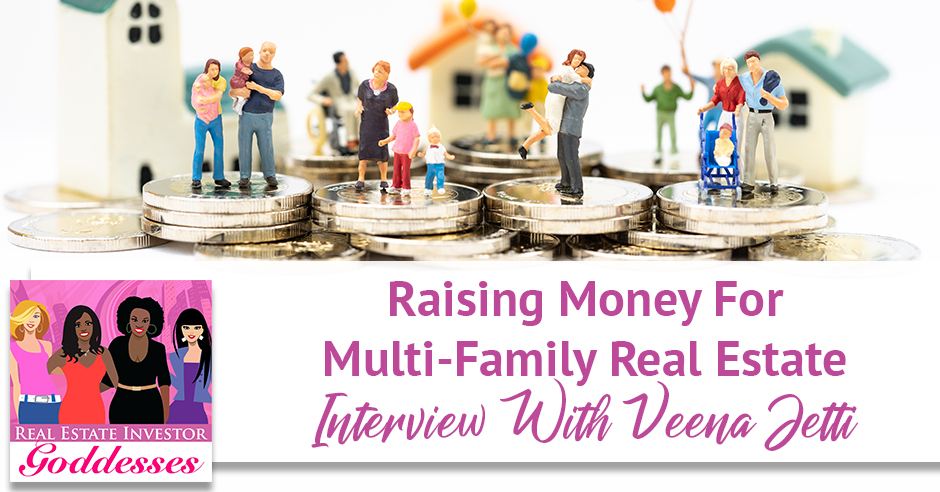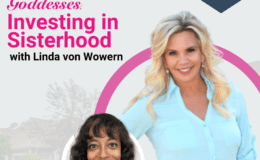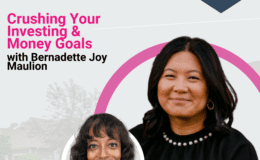
Raising money for your multi-family real estate business is not as hard as you think it is. Multi-family investments are very scalable models and easier to finance, allowing you to do a lot more. Founding Partner of Enzo Multifamily, Veena Jetti, knows the ins and outs of raising money for multi-family real estate investment. In this episode, Veena shares some tips on how you can improve your multi-family empire and how to hold a conversation with your investors. Don’t miss out as she shares some advices on capital raising, finding the right partners, and more that can help you grow your real estate business.
—
Listen to the podcast here:
Raising Money For Multi-Family Real Estate — Interview With Veena Jetti
On this show, we bring you badass real estate investing goddesses and women that are crushing it in the real estate investing game. Our guest is certainly no exception. I’m excited to introduce you to Veena Jetti, who is the Founding Partner of Enzo Multifamily. She has over ten years of real estate investing experience, including overseeing the management of more than $1 billion real estate assets. In 2017, her company acquired over $200 million in multifamily assets. Her experience includes driving corporate growth strategy, asset management and business development derived from working for multiple Fortune 500 companies. Welcome, Veena.
Thanks for having me. I’m so excited.
Thanks for coming. You have an incredible amount of experience. It’s huge numbers. How did you start investing?
I come from a real estate family. I cheated it and took the shortcut by having the foundation already built by my parents. They started investing in real estate many years ago. They started in the single-family game. That’s how I started. It became a scalability thing. For me, I wanted to be able to scale faster. That’s when multi-families was the natural next step.
What was the first actual property you got by yourself?
It was a condo in DC. I bought it with my husband for us to live in, but I bought it with the idea that we would live in it for two years out of the five years that we owned it. We had the capital gains exemption when we sold it. I was like, “We’ll live here for two years and then we’ll move somewhere else. We’ll rinse and repeat,” which is what my parents did with us growing up. Every two years, we moved to another house. I bought this condo with the idea of it being an investment. I still own it and it’s been more than five years. We didn’t even live in it for the two years that I had planned. It became an investment and we’ll probably 1031 it. That was the first investment that I did with just my husband.
You started with this condo. How did you get into multifamily?
I started with a condo and bought more assets in DC. It’s the same formula. My husband and I moved to Dallas, Texas because DC was ridiculously unaffordable. We were like, “We want it somewhere we can have a yard. Eventually, when we have a family, we can send them to public schools.” That was what we wanted. We were looking at jobs in different areas. Dallas ended up shaking out. We moved here in September of 2013. I started buying single-family homes here, also. I was doing the buy, rehab and hold, fix and flip model. I was up to buying five houses in a week sometimes. I was aggressive but it was so much work and there are only so many houses you can buy at a time.
At that point, I was like, “We need to start looking at multifamily.” I thought the next step was duplexes and tenplexes and working my way up. When I met my partner Sapan Talati, he’s my other founding partner. He was like, “No. This is going to be much harder to fund.” He’s our financial genius. I was like, “Great. You do the numbers and I will do the rest.” We started investing in multifamily together and we’ve done a lot of projects together since outside of multifamily as well, but multifamily has been the one that’s always been the most stable that we can always come back to. You’re in multifamily too, so you know why I love it as much as we do. It’s a scalable model. It’s easier to finance. It allows you a lot more wiggle room on your line items on your budget because when you’re a single-family home and you have one vacancy, all of a sudden it’s 100% vacant.
You’re losing money.
Whereas when you have 100 units and you have one vacant, you want five of them to be vacant. You’re operating more optimally.
That’s great. You said you’ve done some other asset classes too. What are some of the other ones you’ve invested in?
We’ve done new construction. I probably will never do that again.
It doesn't feel like work when you love what you do. Share on XGround-up development of what? Was it multifamily?
No. We did custom luxury homes. It’s not an asset class that I prefer. Here’s the problem. When you’re doing custom luxury homes, you’re looking at the jumbo loan size. They’re mostly $1 million-plus. The problem is in a down market, you don’t want to be caught holding those assets because they don’t move and there are few buyers for them. It’s a much riskier venture for us personally in multifamily. That’s why I don’t prefer it. I’ve also learned some of the hard knocks lessons of contractors that maybe aren’t as above board as you would hope. We’ve had them. We have those experiences. I like multifamily. It’s straightforward and clean. There’s not a whole lot of room for negotiation in terms of, “It’s 37% versus 39% complete.” I prefer it a lot more. We’ve also done some land deals. They’re slower-moving, a little bit different and not as exciting for me. I do invest in commercial spaces and some businesses as well. It’s the gamut.
It’s been quite a range but multifamily is still your favorite.
That’s the darling of my portfolio.
You started touching on some of the challenges. I always ask my guests, what was your biggest mistake from it and what did you learned from it? You learn so much more from things that don’t go well.
I’ve made a lot of mistakes. One of the things we’ve improved on a lot in multifamily specifically is our process and our cadence. When we first started, we had too wide of a focus and we didn’t narrow down exactly what we wanted to do. That’s in general, not even with multifamily specifically. That’s why I have invested in a lot of these asset classes because everything’s shiny and pretty. Everybody’s making money, buying notes or wholesaling. Everybody was making money and it’s tough to not be like, “I’m going to do that and I’m going to do this and I’m going to do this.” You’re going a mile wide and an inch deep. You want to go an inch wide and a mile deep. That was the biggest thing that we’ve now perfected. I will admit, I now passively invest in all the pretty and shiny things. Instead of trying to do them myself as an active investor, I’m letting somebody who has more experience in that area run with it. I write a check and collect my check back. That’s probably the biggest mistake and challenge that we’ve tried to overcome.
It’s doing too much, being too broad. Now, you’re focused on multifamily.
Even within multifamily, we’ve narrowed down even more. We do those solid B-assets and we look for A-locations. The thing that everybody says is no one is not looking for this asset class, but we stay disciplined and only go after deals that fit this asset class. We’re focused on our markets. We’re focused in DFW because it’s home, the Florida market, Tampa, Orlando and Jacksonville. That’s going to be more of our focus. If we do anything in other markets like in Atlanta, Memphis or Charlotte, those will be strong operating partners who have that market as their focus.
What do you like so much about Florida?
Florida has a lot of runways still. It’s reminding me of where we were with Dallas years ago. Dallas is now starting to get a little bit overheated. It’s getting a lot of attention. There’s a lot of movement here with Fortune 500, Californians, New Yorkers, everybody’s moving to these no income tax States. Texas is one of them. Florida is another. We like the Florida markets also because there’s a lot of population and job growth happening there. Jacksonville has been a sleeper city. It’s starting to now get on some radars. It’s coming off the Fanny naughty list and Freddie has been transacting a lot more there as well.
We like the Jacksonville market. The challenge in Jacksonville is it’s the largest city in the country by land area. It’s 845 square miles. It’s a fun bar trivia. What that means is you have to know that market because it changes block by block there. We see a lot of movement there. We’re excited about what we’re seeing. Wayfair’s opening a 500,000 square feet warehouse there. Lowe’s is moving. They’re scouting a location there. There’s a lot of solid jobs there that we look for in our fundamentals when we’re going after multifamily.
I like that. The other question I like to ask is, “What are you the most proud of?”
I’m most proud of the team we’ve built. We have partners that I adore working with. All of my partners bring such strength to the table. I feel that it’s tough to form a partnership where there’s complete trust amongst everybody. We have four partners. We all have relationships with each other outside of the other partners. We all bring different strengths to the table. We fight, resolve it and we move on. It’s a dynamic team we’ve built. For me, that is intangible that not everybody gets. I recognize that sometimes I’ve had not great partners and now I have partners that I love. I’m excited about that.

Multi-Family Real Estate: Multifamily investments are very scalable models and easier to finance.
What do you think contributed to you being able to create that team or being part of this great partnerships?
All of us are opinionated. We all bring our ideas to the table strongly but there’s a baseline of respect between us that at the end of the day, we’re all working toward the same goal. We all want the same things. The thing that all of us share that’s important is we’re all good about getting out of each other’s way. What I mean by that is my partner, Puja, for example, she’s a marketing and brand strategy guru. She is fantastic at it and there’s no doubt in my mind that she’s the best at it. I have an emphasis on marketing too, by way of education.
Sometimes I know more than I know. We’ll get on a call and I’m like, “Puja, this is what I want to do and this is why I want to do it.” She like, “No, you’re wrong.” We’ll discuss about it and it’s an open dialogue. Everybody’s allowed to bring ideas to the table. She’s like, “I need you to trust me on this.” I’m like, “I’ll get out of your way because this is your jam. You know what you’re doing here.” All of us have enough knowledge of one another’s feel that we can be a second set of eyes or be a devil’s advocate situation. We’re good about letting each other shine and do what we do best.
What’s your main role in the partnership?
I’m the client-facing investor relations CRM. I face our vendors, investors, and liaise between the external and internal workings of the company. That’s my jam.
To what do you attribute your success?
It’s not all dumb luck. It’s having the support of my family. It’s nice to be able to call my mom or dad up and be like, “This is what’s happening on this property. What do I do?” They understand it. They know when they can talk through it with me and give me feedback. I don’t have to worry about filtering air or anything like that. That’s a nice-sounding board to have. Also, I have a lot of mentors. You were involved in one of the sessions that I attend monthly where I have people that are successful in this field and they are a wealth of knowledge. I’ve asked you questions of how to handle difficult situations and it’s reassuring having other people in those positions that can say, “Here’s what you need to do,” or can give you that outside perspective.
It’s so hard sometimes. I remember when I was raising for our first deal, I didn’t sleep for six weeks thinking that we were not going to close this deal. I didn’t know where it was going to come up with another $1 million. I remember thinking that so clearly. Now, every time a new syndicator reaches out to me, I’m like, “This is going to be the hardest thing you ever did. You’re not going to sleep for the next six weeks. You’re going to think you’re going to fail, but after you get over this, it gets a lot easier. Call me when you need to vent about it and I get it. I’ve been there.” I feel that no one talks about it. You need those people that are normal, “I’ve been there. You’ll get through it.”
Absolutely. You need those cheerleaders, people who you can cry to and people who are like, “Here’s what you need to do now.”
We’re people who would tell you, “This is a totally normal thing that happens to all of us. You’re not crazy.”
Especially when you’re first starting and trying to raise money and nobody knows you as a money raiser yet.
I had the good fortune of having a corporate background and having a family track record. I came into this with a track record. It was easy for me to point to that, but a lot of people don’t have that so you’re borrowing from your partners and other co-sponsors. You’re borrowing their resume, but you may be asked questions that you don’t know the answer to and that’s a tough situation to be in when you’re first raising. Do you remember?
Yeah. I still have questions. I was like, “I’ll get back to you.” People need the confidence to know that that’s an okay answer to say, “That is such a great question. I’m going to talk to my partner. I’m going to find that answer and get back to you shortly.” That’s okay.
Having the ability to control a conversation and bring something new to the table makes you more memorable. Share on XMy poor partners, I throw him right under the bus when I need to. I’m like, “That’s totally my partner’s field. Let me talk to him or her and I’ll get back to you.” That’s okay. You’re not going to know every question to everything until you’ve been doing this for so long that you can do this in your sleep. It’s an acceptable answer, “I’m not sure. I don’t want to give you inaccurate information. I’ll get back to you,” and get back to them. Follow up. That’s the important part.
People will respect that. They don’t expect you to know everything. When you’re starting, you feel like, “I should know every answer to every question. They’re never going to trust me.” They trust you when you say, “I’m not sure but I know where to get that information. I’ll be right back.”
That’s exactly it. As a capital raiser, one of the harder things, when you’re first raising capital, is you have investors that ask you questions that you sometimes are not even expecting. Even to this day, I have questions that I’ve never been asked. Now, because I’ve been doing this so long, I typically know the answer. I can formulate the answer on my toes but what I usually do or what I’ll ask investors sometimes if they’re asking me something and it’s not typical or if they’re starting to go down a rabbit hole is why they’re asking me that. It’s maybe a little nugget of information that took me a while to learn through trial and error. For example, cap rates, that is one that investors love to talk about. “Why is the cap rate on this 4.5% or 5.5% or whatever? I can get a 10% cap with a 10% cash on cash on this other project I’m looking at.”
At first, I was like, “How do I respond to that?” Now that I’ve done this a lot, my response to that is, “10% cap, let’s talk about what a cap rate is and let’s talk about why we care about the cap rate.” I always direct it back to them and ask them, “Why do you care about the cap rate? What is it that you’re looking for? Are you looking to compare two different deals? Are you looking to compare the market and the stability of the market? Are you looking to compare for overpaying for the asset?” There’s a variety of cap rates. They’re not only you’re going in cap, but there’s also the seller’s exit cap, operating cap, exit cap, and reversion cap.
Cap rates can be a little bit more art than science sometimes too.
That’s exactly it. When we first underwrite, we always set the ingoing and outgoing cap rate equal with no movement. We do that because we want to do an apples to apples comparison. To be conservative, we adjust and typically ten basis points per year plant hold is the rule of thumb. For example, I have an investor that sent me an email recently and said, “You only adjusted 50 basis points up on your exit cap.” Historically, in this market, cap rates have remained flat for the last five years. They’re probably not moving and we’re going in at a 5.5% cap. The market’s at a 4.9%. We’re already going in above where everybody else is going in. He wants us to move at 150 basis points over a five-year hold. That’s not going to happen. Maybe it will. It’s always possible.
Better be conservative.
We’ll do a sensitivity analysis to see what happens in those scenarios. What I always do is I always direct it back to them and ask them, “Why are you asking this question? What are you trying to find?” A lot of times they don’t know why they’re asking about cap rates so I always ask why. When I understand why, I can direct them a little bit better. When they start comparing a 10% cap, I always pushed back with, “You’re getting that in Boise, Idaho,” or wherever. It’s not going to typically be your DFW, Charlotte, Memphis, and Atlanta. It’s not going to be those markets and it’s not going to be the B-assets in those markets more specifically.
It’s a C-minus?
Yes. It’s going to be those C minus maybe those even D assets or it’s going to be in tertiary markets or markets that you don’t necessarily want to be invested into when there is a market correction or market downfall. It depends on your risk portfolio. That’s always my feedback, “If you’re finding a 10% cap in Orlando or DFW or Jacksonville on a B-asset, send me that project because I want to invest in that too. I’ll put my money in.” It’s never an apples to apples comparison. It’s helping your investor understand and it’s an important educational piece because they understand how you’re looking at deals and what deals they can expect to see from you in the future.
That’s super great advice.
I was going to say it’s more information about cap rates than you ever wanted to discuss.
It’s important because that is something. For the sake of no goddess left behind, explain what the cap rate means.

Multi-Family Real Estate: Instead of trying to do everything yourself as an active investor, let somebody who has more experience in certain areas run with it.
The cap rate is your capitalization rate. What you’re doing is you’re taking the NOI of the asset and dividing it by the market value to see how quickly you’re recapturing the price of the asset, essentially.
It’s your return on investment figure. That’s the cap rate. When they’re looking at cap rates in the market, they’re looking at, what is the typical in that market for that type of asset. That’s to explain to people that are like, “What is a cap rate?” Everyone reading is going, “I don’t know. I didn’t have a cap rate four years ago. I never heard that term before.”
Once you get started in capital raising, you will know everything there is to know about cap rates because you will get to ask that question. There’s a lot to know about cap rates. Even then, I don’t like to look at cap rates. We use it as a quick rule of thumb. We don’t typically focus on that as much as most passive investors focus on it. It’s 1 of 1,000 metrics we take into consideration. It’s never a big focus for us. We care more about where can we operate and where can we exit.
What advice do you have for a woman who’s starting out in this field?
I always get asked that. I want to tell them everything that I’ve learned over the last several years. At least for me, the two things I will say is number one, find the right partners and partner with them. You and I partner with other people all the time. We partner with new investors all the time. Somebody took us under their wing and we pay it forward. There are not many women in the space. I know you and I get excited when we meet other women that are killing it in their field. Especially if you’re a woman or a young woman looking to break into this, maybe you’re looking for a career change, or your kids are grown and you’re ready to get back into the workforce and this seems something you’re interested, reach out to people that are in this space.
We are typically happy to help. I feel that all the women I’ve met in this space are so helpful and so knowledgeable and they can help maneuver around certain challenges that women particularly faced in this space. That’s number one. Find a partner and mentor and go with it. Then the second thing is, do not fall into analysis paralysis because I know it’s easy to get into that space. It seems overwhelming. When you’re talking about a $10 million deal, it feels like, “How am I ever going to do this?” Be confident. Have you read that study where 70% of men will apply for a job that they’re not even qualified for because they say they want it and for women, it’s 10% or 20%? It’s much less.
They feel that they need to click every single box.
Don’t do that. Being a woman in the space is powerful. You may be the only woman in this room. It’s a powerful thing because you have the ability to control a conversation because you bring something new to the table. You’re somebody that people aren’t used to seeing that face. You’ll be more memorable. There’s a lot of strength in that. Embrace that and be confident. Go forward and do it.
That’s great advice. Lastly, before we get into the trinity, what do you wish you’d known at the beginning that you now know?
Everything. The more I know, the more I’m like, “I don’t know what I don’t know.” The more you learn, the more you realize there is to learn. It’s like that space. The biggest thing for me would have been spending time investing in processes upfront. It probably would’ve saved me a lot of time along the way and allowed us to grow a little bit faster. Investing time into putting those processes into place probably would have helped early on.
It’s like business processes and systems.
Yes. I wish I could go back and I would redo that right from the beginning instead of trying to do some of them now. It’s tough.
It’s important to remember that real estate investing is a business. Set it up that way from the start.
I agree.
Embrace your situation and be confident to just go forward and do something about it. Share on XThat’s great. Before we get into the trinity, what is the best way for ladies to reach out to you and find out more about what you do?
I look at all of our submissions on our website, EnzoMultifamily.com. There’s a button that says Retire in Luxury or Schedule a Call. If you press either one of those, our admin will get you on a call and we’ll set something up so we can talk. It’s a 45 minute to a 1-hour conversation where you can ask me what questions you have, if you want to maybe partner on something or if you’re looking at something that you think we would want to partner on or invest in, we run the gamut. It’s free for all at that moment.
It’s time for our famed end of show trinity, which is a brag, a gratitude and a desire. What’s the one thing you’re celebrating? What’s your brag?
We are under contract on one and about to be two more deals in Jacksonville. I put out an LOI for another one in Orlando. I’m sending one more for another Jacksonville deal. We have a lot of deals in the pipeline, which I feel that we’ve waited so long to get more deals in the pipeline, and now it’s finally here.
That’s well bragged. What are you grateful for?
I’m so grateful for my family and grateful for my partners. I have a lot of great people in my life. It’s like what Suze Orman said, “People first, thing or money second.” That is right on. I have a lot of great relationships in my life. I’m lucky.
That’s beautiful. Last but not least, what is the one thing you desire?
I desire a lot of things. That’s a difficult question to pinpoint. I would love to achieve a better work-life balance, which is a goal. I would love to have more time and I truly am present and dedicate to my family when I’m with them and step away from work for a little bit.
I hear you and it’s hard. When it’s your business it can be 24/7.
It doesn’t feel like work when you love what you do, so it’s hard.
So shall your desire be, or so much better than you can imagine.
Thank you.
You’re welcome. Thank you. This was awesome. If you want to connect with Veena, you can find her at EnzoMultifamily.com. To connect with me, go to REIGoddesses.com and there you can join our community of women from all over the world who are doing real estate and get lots of goodies and other fun stuff. Subscribe and join us next time for another badass Real Estate Investor Goddess interview.
Important Links:
- Enzo Multifamily
- Sapan Talati – Sapan Talati’s LinkedIn page
- Puja Talati – Puja Talati’s LinkedIn page
- EnzoMultifamily.com
About Veena Jetti
 Veena Jetti, Founding Partner at Enzo Multifamily, has 10+ years of real estate experience including overseeing management of $1B+ in real estate assets. Her expertise includes driving corporate growth strategy, asset management, and business development derived from working for multiple Fortune 500 companies. Her background includes acquisition, syndication, and growth strategy for multifamily assets. She is often a panelist and speaker at various global conferences and radio shows.
Veena Jetti, Founding Partner at Enzo Multifamily, has 10+ years of real estate experience including overseeing management of $1B+ in real estate assets. Her expertise includes driving corporate growth strategy, asset management, and business development derived from working for multiple Fortune 500 companies. Her background includes acquisition, syndication, and growth strategy for multifamily assets. She is often a panelist and speaker at various global conferences and radio shows.
Veena is also a founder and past board member of a national non-profit organization. In 2017, she spent a lot of her time and focus on aiding the victims of Hurricane Harvey through coordinating emergency dispatch and rescue calls. Since Harvey, her ongoing rescue work involves helping companies and non-profits understand how they can be better prepared for disaster response. Veena has an undergraduate degree in Finance from the University of Illinois Chicago.






Jett
March 17, 2021 12:23 pmWow! In the end I got a web site from where I can genuinely get helpful facts
regarding my study and knowledge.